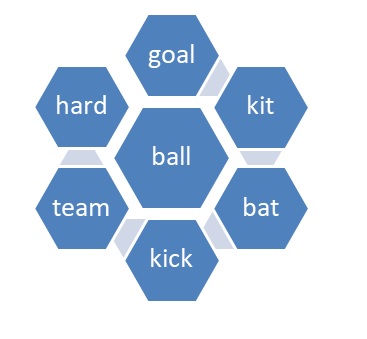On this page
Download leaflet
Word Finding activities and word wheel older children (547kB)
Introduction
Word finding difficulties occur when a child knows what they want to say but cannot access the correct vocabulary. Sometimes they may:
- Take a bit longer to ‘find’ the word, so they may pause or add in a phrase such as “um, you know”.
- Describe the word e.g. “it’s a big white thing you put things in, in the kitchen, to keep them very cold…freezer”
- Not be able to retrieve the word at all, which is often very frustrating for them.
- Produce a word which is linked by its meaning (i.e. knife instead of fork) or linked by how it sounds (i.e. cork instead of fork). Or the child may produce vague, non-specific words such as thingy, something, somebody, it, etc.
Sometimes it can be difficult to identify when a child is experiencing word finding difficulties, as many children develop quite sophisticated coping strategies. It is often most useful to note down words that the child has struggled with to reinforce later. The activities below can also help to build up a child’s vocabulary. Pick from the activities below that are most suitable for the age and interests of the child.
Activities
Things that go together
From 3 pictures, find 2 that go together, explain why, and think of 2 more items for that category.
Odd one out
From 3 pictures, identify the odd one out and explain why.

Semantic Links
- Print target word in a circle in the centre of the worksheet.
- Draw a series of smaller circles around, connected to the centre by lines
- Pupil thinks of associated items
- Pupil draws a picture of the target word at the bottom of sheet.
- Print target word in a circle in the centre of the worksheet.
- Draw a series of smaller circles around, connected to the centre by lines
- Pupil thinks of associated items
- Pupil draws a picture of the target word at the bottom of sheet.
Word Search Game (Johnson, M 1994)
- Family – What group does it belong to? What object/words are from the same family?
- Function – What does it do? What do we do? Who?
- Time/Place – When? Where?
- Association – What else goes with it?
- Appearance – Size? Shape? What is it made of? Colour? Look? Parts? Sound? Smell? Texture? Age?
- Reaction – How do you feel about it?
What do you see?
- Use either a simple line drawing or a non-complicated picture.
- Describe what you can see without showing the picture to the child.
- Ask the child to draw the same.
- Give the child a picture to describe to you. Encourage the child to give specific and appropriate information.
E.g. There is a house in the middle of the page
There is a big door on front of the house
There is a big tree on the left side, etc.
Alternatives
- Play games where you and the child identify an item and then have to think of an alternative word to describe/name it.
E.g. Aeroplane – jet
Jumper – pullover
Pyjamas – bedclothes - Similarly the child can think of things that go together e.g. “Toothbrush and …”
Schools can find further advice and ideas in the Primary School Toolkit: share appropriate ideas and advice with the child’s Parents/Carers so they can support the child at home too.

This information can be made available in other languages and formats if requested.
Please have a look at our virtual map prior to your visit. Here you will find:
- 360° walk-through of over 188,000 square feet of Alder Hey captured in 4K.
- 156 interactive ‘hotspots’.
- 74 videos explaining what happens when you have a procedure or arrive for an appointment.
- Virtual signage to help you find your way around.
PIAG: 596